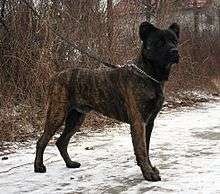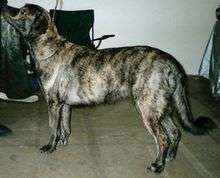Cão Fila de São Miguel
 | ||||||||
| Other names |
São Miguel Cattle Dog, Chien Fila de San Miguel, Saint Miguel Cattle Dog, Azores Cattle Dog, Azores Cow Dog, and other versions and translations | |||||||
|---|---|---|---|---|---|---|---|---|
| Origin | São Miguel Island, Portugal | |||||||
| ||||||||
| Domestic dog (Canis lupus familiaris) | ||||||||
The Cão Fila de São Miguel (frequently translated into English as the São Miguel Cattle Dog or Cattle Dog of São Miguel Island, but other names, such as Azores Cattle Dog, may be used) is a dog breed of molosser type originating on São Miguel Island in the Azores, an island chain which is one of the autonomous regions of Portugal. The breed was originally used for working with cattle.
Appearance
A large dog, but not oversize; up to a maximum of 60 cm (23.6 ins) at the withers and 35 kg (77 lbs) in weight, with females slightly smaller. The general appearance is of a normally proportioned, deep chested, muscular dog with a broad head and medium length neck, straight back, and long legs. The tail is held up and is slightly curved. Ears are drop unless they are cropped. The coat is a brindle of brown (pale brown is described as fawn) or grey, with black; it is short, smooth and harsh to the touch, with a short fringe on the tail (if undocked) and on the backs of the rear legs.
History

The breed is named for São Miguel Island in the Azores, settled by the Portuguese, beginning in 1439. Another of the Azores, Terceira Island, is known for bullfights and cattle raising; large dogs used on cattle there were brought to São Miguel Island and contributed to the development of the breed.[1]
According to the original breed standard, the existence of the Cão Fila de São Miguel has been documented since the early 19th century. A breed standard was developed in the breed's area of origin and first published in 1984. This standard was recognised internationally in 1995, when the standard was published by the FCI. Although described (and formerly used) as a cattle dog, the Cão Fila de São Miguel is actually a Molosser, and is so recognised by the FCI in Group 2, Section 2, Molossoid breeds (number 340.) Today it is primarily used as a companion.
Traditionally, the tail is docked, although this practice is now illegal in many areas. In addition, the ears were traditionally cropped short.[2] The ears are cropped short and rounded off on top. The reasons for these traditions are unknown but believed to ensure tails and ears cannot be bitten by cattle when herding.
Today, dogs from São Miguel are exported to North America and other areas of the world where they are bred and promoted for the rare breed market. Minor kennel clubs and registries maintained by individual breeders write their own versions of the breed standard, which may vary from the breed standard developed on the island of São Miguel and recognised internationally by the FCI. Dogs of the breed may be sold under the original breed name, Cão Fila de São Miguel, or any of the many translations and versions of the name.
Temperament
A medium-sized working dog. As with all working dogs, it must be given regular training and a job to do. Temperaments of individual dogs may vary greatly. These dogs are family friendly and loving dogs, they like to cuddle and be near their owners. Suitability of an individual dog for a particular kind of work may depend on the quality of early training. This breed creates a deep bond with its owner, being very gentle, loving and receptive. When trained well, these dogs make fantastic family pets as they are highly intelligent and docile. [3]
Activities
Cão Fila de São Miguel can compete in dog agility trials, obedience, flyball, tracking, and herding events. Herding instincts and trainability can be measured at noncompetitive herding tests. Azores Cattle Dogs exhibiting basic herding instincts can be trained to compete in herding trials.[4]
Health
Cão Fila de São Miguel from Portugal have no documented health problems, but dogs bred elsewhere are often bred to be very oversize (over 60 cm/23.6 in and 35 kg/77 lb) and may suffer and other ailments particular to deep chested oversize dogs, such as bloat.[5]
Life expectancy of the Cão Fila de São Miguel is approximately 15-years.[6]
See also
- Herding dog
- Guard dog
- Molosser
- List of dog breeds by country
- Cão de Castro Laboreiro (Portuguese Cattle Dog or Portuguese Watch Dog)
References
- ↑ Breed standard, history section
- ↑ Dogged by Dog Fights, by Katherine Watt, Vagabond, English language Bulgarian magazine. "Ear cropping is another fighting-dog feature".
- ↑ http://racas.cpc.pt/en/cur/fsm.pdf
- ↑ Hartnagle-Taylor, Jeanne Joy; Taylor, Ty (2010). Stockdog Savvy. Alpine Publications. ISBN 978-1-57779-106-5.
- ↑ Deep-chested dogs are susceptible to gastric torsion
- ↑ "Cão de Fila de São Miguel, Azores Cattle Dog Information and Pictures". Dog Breed Info Center. Retrieved 29 January 2014.
External links
| Wikimedia Commons has media related to Cão Fila de São Miguel. |
- American Temperament Test Society, Cão de Fila de São Miguel results
- Portuguese Kennel Club
- Informations about the Cão Fila de São Miguel